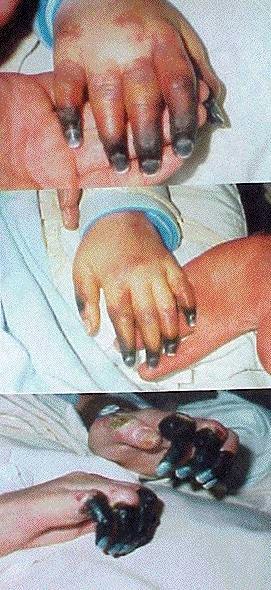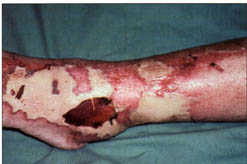|
Rotten Library > Medicine > Necrotizing Fasciitis
Necrotizing Fasciitisaka Flesh-Eating BacteriaThe really scary thing about flesh-eating bacteria is that you've already been exposed to it.Necrotizing fasciitis is the name for a group of diseases which will painfully liquefy all the meat on a victim's body, unless all affected areas are amputated. The most frequent cause of necrotizing fasciitis is Streptococcus A, which you may know better as "strep throat," an extremely common infection that almost everyone in America has suffered at one time or another. (There are other causes of necrotizing fasciitis, but they're even more rare than the already rare strep version).
The most common effect of a strep infection is a sore throat. The next-most severe version of strep is called impetigo, a minor outbreak of skin blisters. According to the National Library of Medicine, impetigo "begins as an itchy, red sore that blisters, oozes and finally becomes covered with a tightly adherent crust. It tends to grow and spread. ... The infection is carried in the fluid that oozes from the blisters." Strep throat almost never becomes necrotizing fasciitis, at least from a statistical viewpoint (and you know what they say about statistics). But when your impetigo is impetigo-going-gone, you just might have a case of streptococcal toxic shock syndrome (if you're lucky) or necrotizing fasciitis (if you're not). STSS, the disease which killed Muppets creator Jim Henson, usually begins with a skin infection or an infected wound.. Within 48 hours of infection, the victim's blood pressure drops dangerously low, and she may experience dizziness, fever, labored breathing, confusion, rapid pulse and peeling skin rash. You can die within two or three days, unless treated with antibiotics and amputation of affected areas. But STSS is still a step down from the king of all strep infections: necrotizing fasciitis. By now, you're probably wondering, "How can I tell if I this annoying rash is really necrotizing fasciitis?" The good news is that if you're in any kind of shape to ask the question, you probably don't have necrotizing fasciitis. The first thing to look for is when your itchy red sores quickly change into yellow-purple swaths of flesh, which grow rapidly leaving a dead black spot in the center, while your pustulent and gangrenous skin excruciatingly cracks open and oozes various liquids, which might be yellow-clear, yellow-cloudy, pus-like, bloody, puslike-bloody, yellow-bloody, or bloody-yellow. Your skin may become cold and pale and bleed uncontrollably. You may also develop a fever or, as referenced in the list of official symptoms, "a generalized feeling of discomfort ... accompanied by a sensation of exhaustion or inadequate energy to accomplish usual activities." Gee, ya think? As if all this wasn't bad enough, expect diarrhea, vomiting, dehydration and kidney shutdown. Fortunately, all this pain and suffering won't last long! Left untreated, necrotizing fasciitis will kill you in less than a week, sometimes much less. Treated incorrectly, it will take longer and be more painful. Treated correctly, it will take what seems like forever, be excruciatingly painful and leave you permanently scarred. About 20% of those infected with necrotizing fasciitis die from the disease.
Unlike leprosy, which was long believed to be highly contagious, necrotizing fasciitis isn't a good reason to shun your neighbors or make them live in special colonies. (Actually, leprosy is no longer a good reason to do that either.) Necrotizing fasciitis isn't especially contagious, but it's good sense to wash out any open wounds on your skin after playing with your necrotized friends. Once the regimen of treatment is completed, there isn't any further risk of contagion. No one knows exactly how common necrotizing fasciitis might be, and it's frequently misdiagnosed. Although reported cases have sharply increased in recent years, it's possible they were there all along. Currently, about 600 Americans per year are diagnosed with the disease, and it's believed that Third World countries have much higher rates of outbreak. While necrotizing fasciitis would be a natural for terrorists using biological weapons, the disease isn't particularly contagious and weaponizing it is problematic since the syndrome is actually caused by a bug that's already extremely widespread. That doesn't stop the occasional report from spreading around the Internet, but these are hoaxes and should be ignored.* *Information provided by Rotten.com should not be used for the diagnosis or treatment of any medical condition. Call a doctor if you're sick. Call 911 if your skin is blotchy, pussy, seeping or necrotized. If you take medical advice from Web sites, you may be diagnosed as an idiot who deserves whatever pain and suffering he gets. |
 The strep bacteria is spread through direct contact, and occasionally through coughing, kissing and
The strep bacteria is spread through direct contact, and occasionally through coughing, kissing and  The good news is necrotizing fasciitis is extremely rare. The bad news is that there's no way to prevent it. You can improve your odds slightly by becoming a hygiene freak and treating even the smallest scratches with antibiotic ointment, although if everyone did this, the bacteria would eventually evolve to become resistant to antibiotics, which would be much, much worse for humanity. But if you don't give a shit about humanity -- hey, go for it.
The good news is necrotizing fasciitis is extremely rare. The bad news is that there's no way to prevent it. You can improve your odds slightly by becoming a hygiene freak and treating even the smallest scratches with antibiotic ointment, although if everyone did this, the bacteria would eventually evolve to become resistant to antibiotics, which would be much, much worse for humanity. But if you don't give a shit about humanity -- hey, go for it.